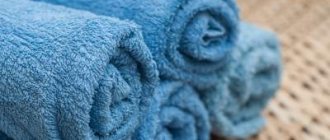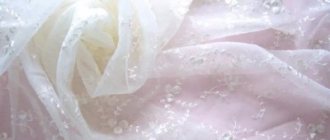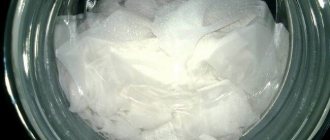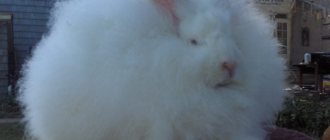Terry towels may lose both their appearance and the softness of the fabric after washing. Restoring products often requires a lot of effort. The set of measures, in addition to chemicals, often includes folk formulations. The effect of each of them must be verified through testing. Every housewife should know how to make terry towels soft and fluffy after washing.
Why do towels become stiff after washing?
To avoid having to restore softness later, you should pay utmost attention to washing new towels and understand why they become hard over time.
The main causes of hardness are cheap washing powder and hard water. Also, the softness of textiles is affected by incorrectly set washing temperatures that do not match the type of fabric, improper ironing and drying.
In order not to look for means to return softness to towels in the future, always choose high-quality washing powders, set the correct processing temperature, soften the water using improvised or purchased substances.
Water quality
One of the most important criteria for effective washing is water quality. Tap water contains additional impurities that settle on the fibers of the material, thereby making the towels rough and hard. To eliminate this point, monitor the softness of the washing water and, if necessary, use special cleaners and softeners.
Washing powder
If low-quality powder is poorly rinsed from the fibers, after drying the material will certainly become rough and hard. To restore the original appearance, softness and fluffiness of towels, after washing, soak the textiles in plenty of water for 7-8 hours. After this, rinse the towels under running water and set them to dry. After such treatment, the powder will be rinsed out, and the fibers of the material will become softer and more pleasant to the body.
Why did the products lose their softness after being processed in the washing machine?
When buying a new towel, any housewife dreams of maintaining its softness for a long period. However, the product loses its original appearance after each wash. There are five main reasons that lead to hard towels:
Poor quality of tap water . Unfortunately, most regions of Russia use too hard water. Calcium and magnesium salts clog fabric fibers, which negatively affects the appearance of products.- Inappropriate remedy . Particles of inexpensive dry powders get stuck in the canvas, making it rougher. The longer the pile of a towel, the more detergent remains in the fabric, which makes it stiffer.
- Wrong mode . Each product must be washed, taking into account the properties of the fabric from which it is made. Each type of fiber has its own washing mode (manual or automatic, temperature, rinse, spin).
- Errors in product care . This includes violation of the rules of drying, ironing, and storing towels.
- Low quality fabric . Unfortunately, modern industry is designed to produce inexpensive goods that quickly become unusable.
To enjoy the softness of your towels for a long time, you need to clearly identify the cause of the hardness and eliminate it. In each case, either one provoking factor or all five are possible.
How not to wash
First of all, it is worth determining how terry towels should not be treated. It is not recommended to wash them:
- in hard water;
- in unsuitable temperature conditions;
- using cheap powders;
- together with other things.
Housewives often ask whether it is possible to wash towels along with bed linen. In this matter, the type and color of the material is key. If the textile is made from one type of fabric and does not have bright or dark colors on the surface, it can be washed together. Otherwise, if, for example, the towels are made of terry, and the bed linen is made of cotton or linen, washing the products in one mode can lead to an unfavorable result.
Reasons for hardness of bed linen
Calico is a dense cotton fabric of plain weave, so a new product made from this material is always particularly rigid. But many continue to purchase it for their family, as it has high wear resistance and an affordable price.
Another reason for bed hardness can be hard water . In most regions of Russia, water contains large amounts of lime salts. These salts, settling on the fabric fibers, make the bed linen rougher and worsen its quality. In order to soften water, you need to use special products.
How to wash towels to keep them soft
The softness of bath textile fibers is influenced by many factors. Compliance with recommendations and rules for processing terry products will help significantly improve their quality.
We look at the tag
Always read the label information before washing textiles. This will protect your towels from the negative effects of processing modes inappropriate for this type of fabric. Usually the label indicates the recommended cleaning mode (dry, wet, delicate), suitable temperature, ironing and drying features.
Soak
To maintain the softness of the fibers of bath textiles, soak them before washing. Choose the appropriate product and leave the towels in the water for a certain time. For example:
- dissolve table salt in water at the rate of 1 tbsp. spoon per 1 liter of liquid, and leave the product in the solution overnight;
- add 100 g of soda to the soaking water and immerse towels in the liquid for 12 hours;
- use laundry soap or washing powder, dissolving the substance in water and leaving the textiles in the liquid for 10–12 hours.
After soaking, wash away heavy dirt and stains, and only then put it in the drum.
Temperature selection
Select the washing temperature based on the information on the label or the characteristics of the material. For example, light cotton and linen items can be washed at a temperature of 70–95 degrees. For mixed and colored materials, washing in warm water at a temperature of 40 to 60 degrees is suitable.
Machine washable features
To ensure that you are pleased with the result of washing in an automatic machine:
- Before putting a towel into the washing machine drum, try to remove stubborn dirt and stains. To do this, you can use store-bought stain removers or improvised products.
- Pre-sort your towels into light and colored ones.
- Fill the drum to a maximum of 2/3 full.
- Determine water hardness and use softeners if necessary.
- Wash towels separately from other items, especially items with sharp elements.
- Set the washing temperature to the appropriate temperature.
- Start the extra rinse program.
- Use a maximum spin speed of 600 rpm.
- Do not leave items in the drum after washing.
- Dry it properly.
Handwash
You can restore the softness of terry towels by hand washing again. For the procedure to be effective, follow these rules:
- Pre-soak the items in cold water.
- Drain the cold water and fill the container with warm water.
- Add laundry detergent or laundry soap to the liquid.
- Lather the mixture and leave the towels for 30 minutes.
- Wash textiles carefully, avoiding strong mechanical movements and friction.
- After washing, rinse towels in water with diluted vinegar.
- Gently squeeze, but do not twist.
Dry the towels properly after treatment.
How to keep it soft when washing
In order for towels to remain in their original form for a long time, it is necessary not only to wash them correctly, but also to store them. Washed towels do not need to be wringed excessively! If you did not use salt during washing, then soak the terry product in salted water for 20 minutes, then rinse thoroughly again.
Towels need to be dried unrolled, preferably in a ventilated place, but not under the direct sun. Dry only naturally, away from heaters. Bath towels do not need to be ironed.
A few tips to help keep your towels in their original condition:
- Use only liquid detergents for washing, and add salt, acetic acid or soda. Remember about emollients! Buy laundry detergents that do not contain phosphates. When choosing a rinse aid, give preference to products with silicone, thanks to which the product retains its “fluffiness”.
- Always re-rinse items to ensure no detergent remains on the fabric. If you wash by hand, then three rinses will be enough.
- Do not dry items in your apartment if your air is dry. This material needs moist air. It is recommended to hang products horizontally, because in a vertical position they can stretch.
- It is not recommended to set temperatures above 40 degrees during washing.
- Don't squeeze too hard!
- When washing, do not fill the machine with things; at least a third of the drum should be empty. In order to fluff up the pile of the towels a little, you can add tennis balls.
How to go to the toilet in a bodysuit?
Fleece is a synthetic or natural fabric
Determining water hardness
It is a known fact that the quality of water differs in different regions and cities. To subsequently understand how much fabric softener to use, you need to know how hard the water in your tap is. There are several ways to determine water hardness: using tea leaves or regular soap.
With tea
Good quality loose leaf tea will help you find out whether your water is hard or not. Brew a small amount of aromatic leaves. If the brew is light and bright, then the water is good, and if it is cloudy and dark, it is very hard.
Using soap
You can check the quality of water using soap in 2 ways.
- Grate the soap and dissolve in water. If the soap has completely dissolved, then the water is soft, and if there are a lot of soap “flakes” left, then the water is hard.
- Wash your hands with soap. If the soap foams well and quickly, the water is soft; if it practically does not lather, it means it is too hard.
Causes of stiffness
If you initially purchased bed linen from low-quality fabric, the reason for the appearance of stiffness is understandable. In other cases, there are several reasons:
- Careless handling. This category includes boiling, soaking with aggressive agents, ironing without steam.
- Incorrect machine wash. That is, inappropriate (according to the type of fabric) temperature and washing mode, spin speed and rinsing time.
- Improper hand washing. Long soaking and poor rinsing.
- Unsuitable detergents.
- Water. Tap water is full of harmful salts that remain on the fabric.
Regardless of the reason, there are several ways to restore softness to bed linen. Their choice will depend on the specific type of linen.
How to soften towels at home
Use available substances to soften towels and washing water. Such products are inexpensive, but give fairly good results.
Liquid detergents
Use only liquid or gel detergents for soaking and washing. These substances dissolve better in water, remain effective even at low temperatures, and are easily rinsed out of fibers.
Laundry soap
The substance will help restore freshness and softness to washed items. Lightly dampen the towel and rub thoroughly with laundry soap. Pack textiles in plastic and leave overnight. In the morning, remove the towels from the bag and wash them as usual. To remove soap particles from the material to the maximum, do not forget to set the extra rinse mode on the machine.
Soda
You can use either baking soda or soda ash. Just add a little to the drum before washing. This will help soften the water significantly.
Salt
The most suitable salt for softening textiles is “Extra” salt, since it dissolves in water faster. Sea salt also softens fibers well. Add a little salt to the machine tray along with the washing powder or directly to the laundry drum. You can first dilute the substance with water and add it to the detergent tray.
Mustard
The main rule is to use only dry mustard, since the finished product contains many preservatives and other components that can harm the material. Mix mustard powder with water to form a paste. After washing, do not send the towels to dry, but treat them with the resulting mixture, paying special attention to stubborn stains. Leave the textiles overnight and then wash them again.
Lemon acid
Just one packet of citric acid will help deal with old plant stains. To remove dirt, moisten problem areas of the fabric with warm water and soap with laundry soap. Sprinkle the treated areas generously with citric acid and leave for 5-10 minutes. Rinse items thoroughly under running water and wash if necessary.
Soda and vinegar
Substances that every housewife has in her kitchen will help soften towels. Just add 100 ml of vinegar to the conditioner compartment, and pour baking soda directly into the drum with your clothes. You can make a homemade mouthwash using the same substances. To do this, mix vinegar, baking soda and water in a separate container. After the reaction has passed, add a little more water and a few drops of any essential oil to the solution for a pleasant smell. Pour the liquid into a suitable bottle and use it as a rinse aid with each wash.
Vinegar can also be used in its pure form to soften water by adding about half a cup of 9% acetic acid per wash.
Salt and ammonia
Use this mixture immediately after washing. Dissolve 1 tbsp in 2 liters of cold water. a spoonful of ammonia and 2 tbsp. spoons of salt. Leave in the solution for 2 hours, then rinse thoroughly and dry.
Glycerin and ammonia
You can use the substances both to remove stubborn stains and as laundry detergent enhancers.
To prepare a homemade stain remover, mix ammonia with glycerin in proportions 1:4. Apply the cleaning solution to the stains and leave for an hour. After the exposure time has expired, send the textiles to be washed.
To enhance the effectiveness of the detergent, mix the substances in equal proportions and add to the soaking water. Leave the textiles in the composition for 60 minutes, and then wash as usual.
Terry massage ball
Special terry massage balls preserve the texture of the fibers well. Simply place 2-3 balls in the drum before washing and run the wash cycle. When you remove the laundry from the drum after washing, you will be pleasantly surprised because the fibers will remain soft and fluffy. You can replace special terry balls with regular table tennis balls.
Conditioner with silicone
It is worth noting that when using classic conditioners, terry towels do not become better, since the components included in the substances dry out the fabric fibers. To keep towels soft, use only fabric softeners or substances containing silicone. With the latter, the main thing is not to overdo it, otherwise the textile may lose its ability to absorb moisture.
Cold water + snow
This treatment is suitable for residents of private houses in winter. The first step is to soak and wash the towels in ice water. After this, collect clean snow in a suitable container and place towels in it. Leave the textiles in the snow for 2 hours and then rinse thoroughly. It is believed that snow significantly cleans and softens textile fibers.
Home methods and recommendations for softening laundry
vinegar and soda in her kitchen , but few people know that these two components can not only soften hard fabric, but also remove heavy stains.
Softening fabric
with vinegar .
Vinegar is a universal remedy for making fabric soft. In addition to softening the product, vinegar will help housewives remove powder residues from the product, eliminate various odors and refresh the fabric. This is especially true for mothers with small children. To soften items with vinegar, you need to pour half a glass of 9% vinegar and start washing the bed linen.
Softening the product with soda. Regular baking soda enhances the effectiveness of the powder and makes laundry soft and fresh. To soften items made of hard fabric, you need to pour half a glass of baking soda into the empty drum of the machine, and then load the laundry into it.
Softening bed linen with sodium tetraborate . Sodium tetraborate, or as it is popularly called, borax, allows you to soften hard water and enhance the effectiveness of the powder. You can purchase this product at any pharmacy. To apply this method, you need to take half a glass of tetraborate and add it along with the powder to the washing compartment.
How to bleach washed and gray terry towels?
If standard washing does not help remove all stains and dirt from bath textiles, use more radical cleaning methods.
Boiling
Over time, light-colored bath textiles may turn yellow or grey. To return the towels to their previous appearance, use boiling, following the following procedure:
- Dissolve shavings of laundry soap and a little soda ash in 5 liters of water.
- Place the mixture on the stove to heat.
- Dip pre-washed towels into the liquid.
- Bring the water to a boil and simmer the towels over low heat for 20 minutes.
- Rinse textiles thoroughly under running water.
Please note that the procedure is recommended to be used only in the most extreme cases, since boiling makes the terry fibers thinner.
Use of bleaches and conditioners
Increase the softness of fibers and eliminate stubborn stains in forces and store-bought household chemicals. Use special conditioners for bath textiles when rinsing, adding the product to the desired tray of the washing machine or during the last rinse when hand washing.
The active components of oxygen bleaches will help restore the purity of light-colored textiles. Use these products only according to the dosage indicated in the instructions on the package according to the following algorithm:
- Fill the soak container with hot water.
- Add bleach in the required dosage.
- Leave the towels in the cleaning solution for 2-3 hours.
- Rinse the textiles thoroughly and set to dry.
Please note that chlorine-containing substances are not recommended as they thin the terry fibers.
Potassium permangantsovka
Few housewives know that when combined with laundry soap, potassium permanganate becomes an effective bleach. You will need a two-hundred-gram bar of laundry soap and enough potassium permanganate crystals so that, after dilution, the water turns bright pink. Pre-dilute each substance in water in separate containers. After the substances are completely dissolved, mix the liquids in one container. Immerse towels in the mixture and leave to soak for 6 hours. Be sure to rinse after treatment.
Hydrogen peroxide
Hydrogen peroxide will help you quickly tidy up white towels. To prepare the current product, you will also need a little ammonia. Processing scheme:
- Prepare a cleaning solution from 5 liters of water, 50 ml of peroxide and 15 ml of ammonia.
- Pour the solution into a saucepan and place on the stove.
- Immerse the towels in a container, bring to a boil and simmer for 30 minutes over low heat.
- Remove textiles from liquid and rinse thoroughly.
Vegetable oil
To make stains on the material softer and more vulnerable to cleaning agents, use vegetable oil. You will also need laundry detergent, vinegar and bleach to prepare the cleaning mixture.
Procedure:
- Dissolve 60 g of powder, 30 g of bleach, 30 ml of table vinegar in 5 liters of warm water.
- Add 30 ml of any vegetable oil to the liquid.
- Soak the textiles in the solution overnight.
- Rinse and wash items by hand or in the washing machine.
How to make bedding soft and fragrant
Soft bedding is the key to a comfortable sleep. After several washes, the new product becomes much softer, as the starch is washed out of it. But bedding that has become rough from time to time can be helped by either air conditioning or tennis or foil balls.
Air conditioner. The easiest way to make a product soft and fragrant is to use conditioner when washing. You can buy it at any hardware store or supermarket, however, if there are children in the family, then this option can hit your pocket hard.
Tennis or foil balls. Tennis or foil balls will help replace the air conditioner. When washing, balls help remove static on artificial fabrics and effectively fight old stains. To use this simple technology, you need to put several tennis or foil balls in the washing machine along with your bed linen. If the machine has two different sections (washing and drying), then the balls are placed in the drying section. Rolling over the laundry, they will automatically soften the material.
How to remove an unpleasant odor
An unpleasant odor on bath accessories may appear due to the development of bacteria or the spread of fungus and mold. To remove musty odor from fibers:
- Use digestion (recommended only in the most extreme cases).
- Wash textiles with vinegar and soda.
- Dry and store towels properly.
Also keep your bath accessories clean. Even if a towel appears clean, this does not mean that the fibers are free of dust, dirt and bacteria. Experienced housewives recommend washing terry products at least once a week.
General recommendations
Regardless of the type of laundry, when washing it is worth making sure that:
- the spin in the machine was more than 800 revolutions;
- rinsing in the machine was once for delicate fabrics and two for regular fabrics;
- When washing by hand, rinse thoroughly;
- when choosing a conditioner, give preference to products for children's clothes;
- after washing (any) the laundry was straightened;
- the bedding was not left damp before washing in the laundry basket;
- there was no boiling or use of starch, especially for colored and delicate fabrics;
- the laundry was not overdried;
- During washing, there were no foreign objects or laundry of a different type of fabric or color with the laundry.
Features of washing depending on the color and type of material
The type of material and color of the towels affect the washing temperature used. In order not to spoil bath textiles, be sure to choose the appropriate program appropriate for this type of fabric and do not mix light, colored and dark towels when washing.
| Material type | Where is it used? | Suitable mode |
| Mahra | For the manufacture of bath accessories | You can soften the material in various ways. Wash only at a temperature not exceeding 60 degrees using liquid detergents. Press at no more than 600 rpm. Ironing is not recommended. |
| Cotton | For both bath and kitchen towels | It is permissible to wash at temperatures up to 95 degrees, wring at high speeds and iron. You can soften it in all possible ways. |
| Bamboo | For bath textiles | It washes well in cold water and practically does not lose its softness after many washes. It requires careful handling, so it does not tolerate spinning at high speeds. |
| Velours | For bath products | Can only be washed in cold water. Retains softness if you use a delicate wash program and iron with a lukewarm iron. |
| Microfiber | Artificial material for bath and other household items | Does not tolerate exposure to high temperatures. Stays soft for a long time. Reacts poorly to air conditioners, bleaches and stain removers. |
| Linen | Mainly for kitchen textiles | Withstands washing in very hot water, boiling and ironing. |
You can extend the life and maintain the softness of your bath accessories in various ways. Use available substances to soften the water when washing or products to add fluffiness to the fibers. It is worth understanding that proper washing alone is not enough. To maintain the quality of bath textiles, also pay utmost attention to spinning, drying and ironing.
Useful tips
The following tips will help keep your towels soft:
When washing items made from long pile, you need to set the extra rinse function, which will allow you to more thoroughly remove detergent residues.- Load the drum 60–70%, since a large number of items prevents thorough washing and rinsing.
- Do not wash at temperatures above 600. Too high temperatures make the fabric rough.
- Choose silicone-based rinses or those designed for children's clothes. Such products provide softness to products for a long time.
- After washing the product, shake thoroughly and dry vertically in a well-ventilated area or in the air. Direct sunlight and drying on radiators make towels hard.
- Products with long pile should not be boiled.
- It is better not to iron or carry out the procedure with steam.
- It is useful to use a special laundry bag, which will protect long-pile towels from the metal drum of the washing machine.
Laundry Recipes
If all the above conditions are maintained, the following mixtures can be added to the bed linen when washing:
- Recipe 1. Dissolve half a glass of soda in a container with water before adding laundry (for hand washing) or pour the same amount into the compartment next to the powder in the washing machine at the rate of 2 spoons per 5 kilograms.
- Recipe 2. Dissolve one half glass of vinegar in a container (up to 10 liters) with water before putting laundry in it or pour half a glass of vinegar into the department next to the powder when washing in the machine.
- Recipe 3. In case of poor rinsing, the laundry after the main wash is soaked for a day in ice water, then rinsed and hung out to dry.
- Recipe 4. Before washing in a machine or by hand, the bedding is soaked in a container where 3 tablespoons of salt (tablespoons) were previously diluted.
- Recipe 5. When washing in a washing machine, add a tablespoon of citric acid to the powder.
- Recipe 6. Add a tablespoon of salt (table salt, or preferably sea salt) to the powder during hand or machine washing.
- Recipe 7. Before washing, the bedding is soaked in a container with 1 liter of water, previously diluted with 1 tablespoon of salt and a teaspoon of ammonia. Soaking time: 3 hours. After this, the laundry is rinsed and sent to normal washing.
- Recipe 8. Mix a glass of soda, half a glass of vinegar, 4 drops of aroma oil and 2 glasses of water. Pour the resulting mixture into the liquid detergent compartment of the washing machine or into a container of water for hand washing.
- Recipe 9. A mixture of 6 glasses of water, three tablespoons of vinegar and two tablespoons of hair conditioner. Pour the resulting solution into a container of water during hand washing before loading laundry or into the appropriate compartment of the washing machine.
- Recipe 10. Only for white linen. Before the main wash, grate a bar of laundry soap, dilute it in warm water until liquid and dissolve it in a container of water. Dip the bed linen into the resulting solution, wet it completely, and then put it in a bag. Tie it and leave it for 1 day. Then wash in the usual way.
Important! These recipes are not suitable for delicate and brightly colored fabrics.
Note* The use of tennis balls, rubber balls and foil balls is not advisable, i.e. the balls negatively affect the operation of the washing machine, the rubber leaves an odor and can fall apart, and the foil gets stuck in the elements of the machine.
We can sum it up by saying that only attention to detail during washing ensures soft bed linen. But the best preventive measure against fabric stiffness is the initial purchase of bed linen from high-quality materials.
How to make bed linen softer, home methods and recommendations
Do you like the calico bedding set, but are you confused by the hardness of the material? Don't worry, this can be fixed. Use our simple tips to help you make calico soft and comfortable in affordable ways.
When choosing bed linen, preference is often given to inexpensive but practical material - calico. This fabric has proven itself well among consumers, thanks to the use of modern dyeing technologies and durable bright dyes. The main criterion is that the low cost forces housewives to turn a blind eye to the relative rigidity of the canvas, especially since this disadvantage can be overcome on their own. Many fans of calico sets probably have this knowledge, and for those who are just on the verge of choosing, we will tell you how to make calico softer without much expense.
General recommendations
Calico does not require special care techniques. The material is unpretentious and can withstand machine washing. And small subtleties will help you neutralize the stiffness of the fabric to get ideal sleep comfort. For this:
• wash a new set before making the bed with it; • washing temperature should not be higher than 40ºС, calico will easily recover. Add conditioner to cotton powder. And the use of rinse aid at the last stages of the washing program will give the desired softness to the fabric; • try to wash natural fabrics separately from synthetic ones; • choose gentle spin parameters (no more than 600-800 rpm) to avoid the formation of persistent, difficult-to-smooth creases; • dry calico linen until it is “slightly damp” - this will greatly simplify the ironing process.
General information
Most often, these towels are used after taking water procedures, but they can also be found as kitchen towels. However, using them in the kitchen is not recommended. Due to the structure of the structure, which has loops with a loose fit, such towels become very dirty and it is not easy to get rid of the odors that they absorb well.
In order for a terry towel to remain bright and fluffy and not lose its attractiveness, it needs to be provided with delicate care. You should be especially careful when washing. But over time, any towel can become hard and washed out. Therefore, you need to know how you can tidy up such towels at home.










